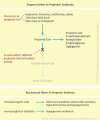Anesthetic Management of Children With Propionic Acidemia Undergoing Esophagogastroduodenoscopy
- PMID: 34707951
- PMCID: PMC8530746
- DOI: 10.7759/cureus.18168
Anesthetic Management of Children With Propionic Acidemia Undergoing Esophagogastroduodenoscopy
Abstract
Propionic acidemia is a rare genetic disorder of metabolism that predisposes patients to metabolic acidosis, lethargy, neurologic dysfunction, developmental delays, and cardiomyopathy. Perioperative anesthetic management is guided toward mitigating the effects of preoperative fasting times, maintaining normovolemia, and preventing cardiovascular complications secondary to underlying cardiomyopathy. Commonly used anesthetic agents may have undesirable side effects in these patients. Propofol, the lactate in Lactated Ringer's, and neuromuscular blocking agents that undergo ester hydrolysis are poorly metabolized and can lead to metabolic acidosis. Opioids, such as fentanyl and morphine, should be used judiciously in patients with coexisting developmental delays to avoid oversedation and delayed time to resuming oral intake postanesthesia. In addition, inhaled anesthetics have direct myocardial depressive effects and can compromise cardiac function in the setting of pre-existing cardiomyopathy. The perioperative period represents a critical time in this population and appropriate planning is crucial to prevent perioperative morbidity. We present a case of an eight-year-old child undergoing esophagogastroduodenoscopy under general anesthesia and describe the anesthetic concerns we addressed to provide a safe perioperative course.
Keywords: anesthesia; esophagogastroduodenoscopy (egd); propionic acidemia; propofol.
Copyright © 2021, Alex et al.
Conflict of interest statement
The authors have declared that no competing interests exist.
Figures
References
-
- Shchelochkov O, Carillo N, Venditti C. GeneReviews. Seattle: University of Washington; 2012. Propionic acidemia.
Publication types
LinkOut - more resources
Full Text Sources

